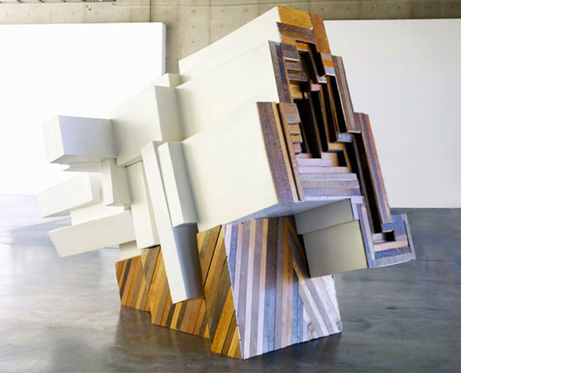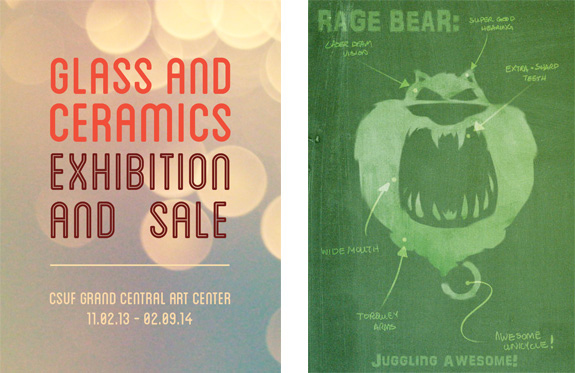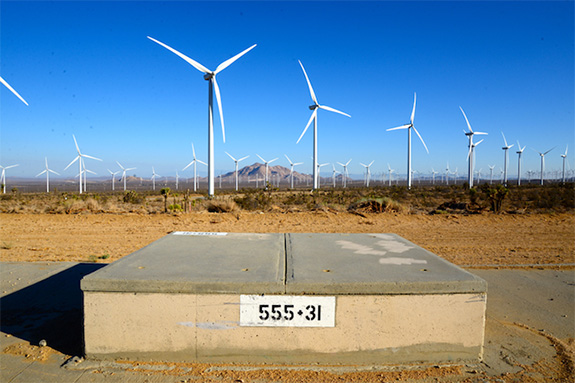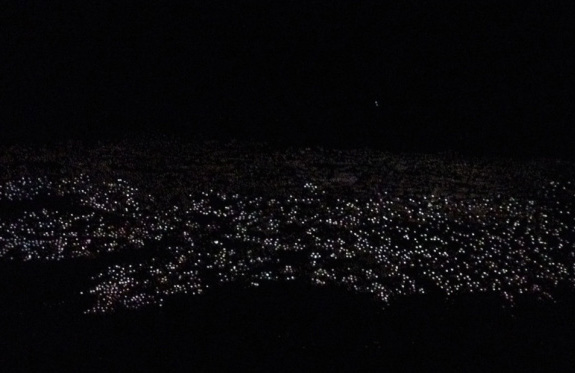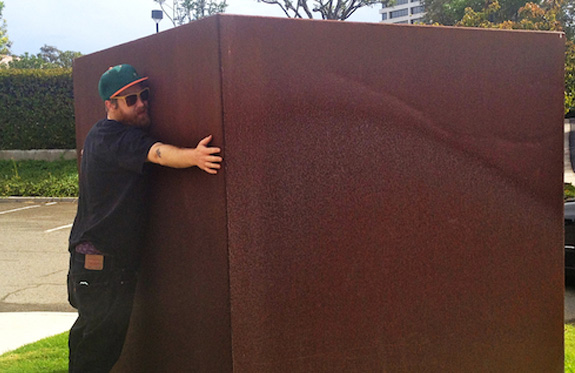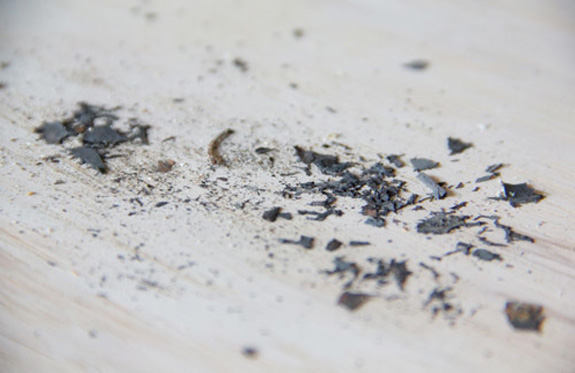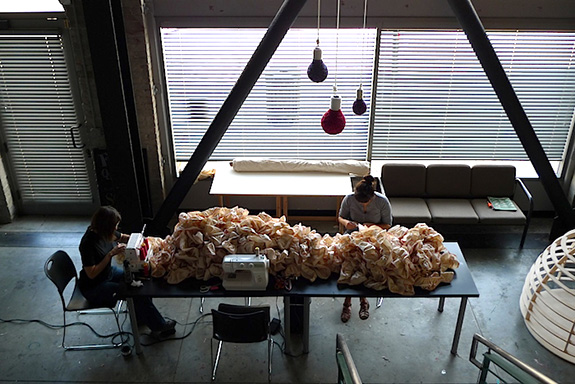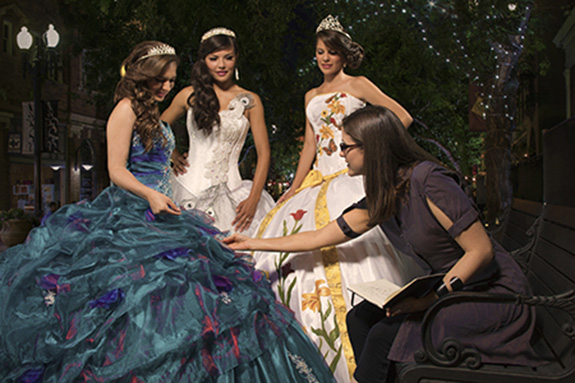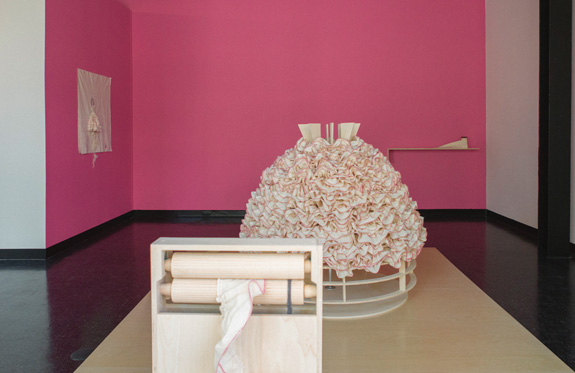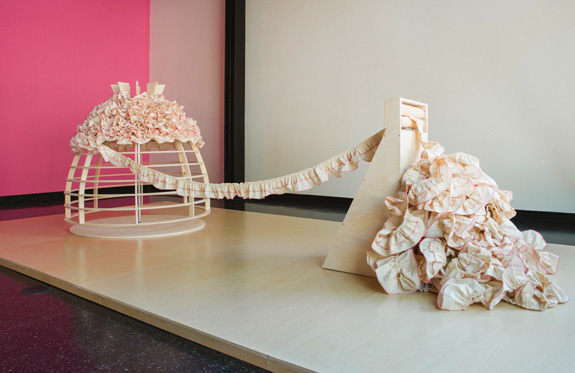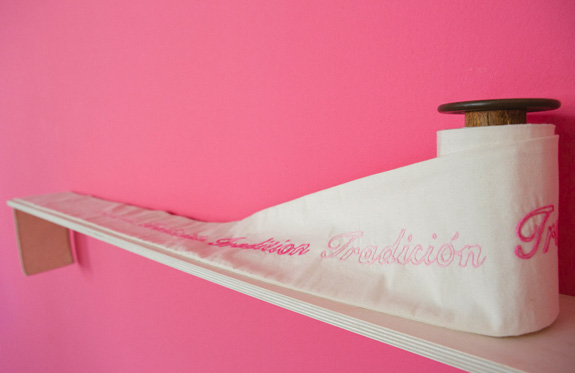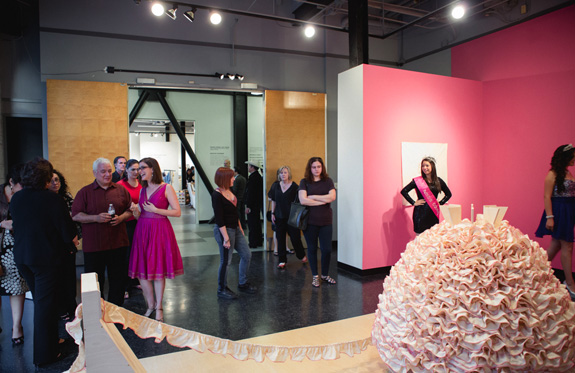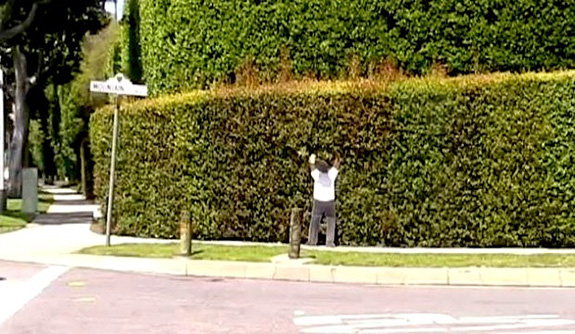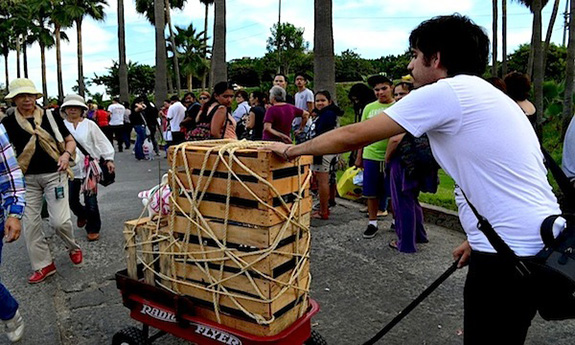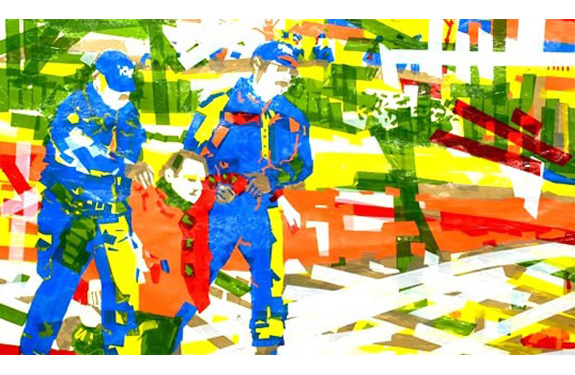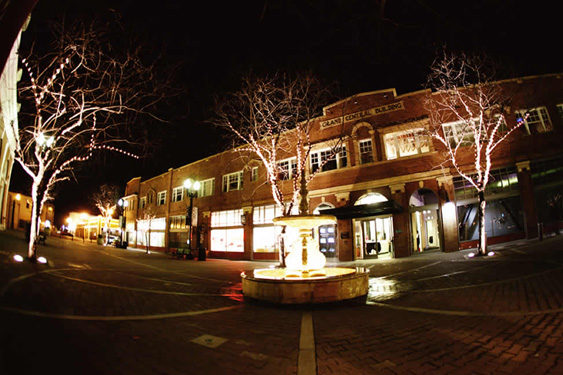2013
2018; 2017; 2016; 2015; 2014; 2013; 2012; 2011; 2010; 2009; 2008; 2007; 2006; 2005; 2004; 2003; 2002; 2001; 2000; 1999
Project Room Gallery
Aili Schmeltz
Cross Cut
November 2 – December 31, 2013
Cross Cut, from Aili Schmeltz’s Tomorrowland series, explores the idea that utopia can be considered not only a place or a goal, but also as the very act of striving for such a target. Schmeltz’s hybridized structures are materializations, remnants of an ideal that never was and may never be. As fallen monuments to a utopic philosophy, they function as relics of both a “good place” and “no place.” Part architectural, part fossil, part potential: these works utilize discarded building materials that appear to have crystallized within a ‘natural’ process – strata that have undergone philosophical transformation yet to be fulfilled.
Exhibition dates: November 2, 2013 – January 12, 2014.
The exhibition opens on Saturday, November 2nd, 7:00 – 10:00 PM. The main reception will take place on Saturday, December 7th, 7:00 -10:00 PM, during the Artist Village Art Walk (artist in attendance)
• • • • • • • • • • • • • • • • • • • • • • • • • • • • • • • • • • •
Education Room
Glass and Ceramics Exhibition and Sale
and
Rage Bear: Juggling Awesome
Curated by Marvin Chow, Illustration MFA Candidate, CSUF
November 2 – December 31, 2013
Glass and Ceramics Exhibition and Sale
A small selection of works from CSUF alumni, students and members of our community will be on display November 2th, 2013 – February 9th, 2014.
Participating artists include:
Aimee Sones (alumna/faculty), Brandon Lipe (student), Chelsea Wonenberg, Diana Donaldson, Elijah Wooldridge, Hiromi Takizawa (alumna), Jose M. Flores (student), Karen Thayer, Kimberly McKinnis (student), Klai Brown, Philip Kupferschmidt (student), Sarah Alonzo, Xin Xin Chen (student)
Rage Bear: Juggling Awesome
An exhibition representing both in-game artwork, concept artwork and fan artwork as it relates to Rage Bear – a concept involving a Bibi bear whose specialty juggling skills allow him to juggle ridiculous amount of objects when he gets angry. Through the invitation of Marvin Chow, 30 Los Angeles-based entertainment artists will develop work for the exhibition, creating part of the Rage Bear storyline in their own personal style.
Participating artists include:
Craig Mackay, Kelly Delanty, Alex Leon, Kevin Bentz, Candice Lee, Jack Sy, Paul Grab, Isaak Lien, Nathan Drobnack, Diana Drobnack, Jerry Ortega, Kingsley Harden, K Godfrey, Ray Mendoza, Corey Peters, Jia Tan, Casey Matsumoto, Eugene Negri, Tiffany Ma, Aaron Jones, Alex Santa Clara
The opening reception will take place during the Artists Village Art Walk in Downtown Santa Ana on Saturday, November 2, from 7:00pm until 10:00pm.
• • • • • • • • • • • • • • • • • • • • • • • • • • • • • • • • • • •
Main Gallery
Matthew Moore and Braden King: Cumulus
Residency/Exhibition with support of the Metabolic Studio
October 5 – December 31, 2013
Grand Central Art Center has invited Matthew Moore and Braden King as artists in residence to explore, examine and reflect upon the impact of the Los Angeles Aqueduct – part of a sixteen institution initiative funded through the Metabolic Studio’s Chora Council grants, marking the LA Aqueduct’s 100th anniversary.
Cumulus marks the first collaboration between these two accomplished artists. Through the residency, the artists set out on journeys – a series of driving trips along the aqueduct. They connected with people who work, live and engage along its path. Their travels allowed them the opportunity to listen to the land and then the water as it rushed down the cascade near Newhall Pass; flowed through massive piping in the Antelope Valley; traversed under slabs of concrete through the Mohave Desert; diverted from the Owens River.
The journey of water is not a foreign concept to artist Matthew Moore; it is actually central to generations of his family’s livelihood. For without the control of water, it would have been impossible for Moore to become the fourth generation of farmers in his family, sowing land in what would otherwise be considered hostile desert environment of western Phoenix, Arizona. Working in the medium of film and installation, Braden King‘s projects often focus on individuals finding their place in the world and how external geographies can act as mirrors to our internal selves – mapping, landscape, geography, work. To quote Zachary Wigon’s in Filmmaker Magazine (Apr 11, 2012) regarding King’s 2011 film HERE, “is about nothing so much as having an appreciation and understanding of where one is.”
The site-specific installation Cumulus is a culmination of a residency that allowed for multiple site visits, time to talk, and time to travel outside the institution. To quote King “It’s been a truly creative collaboration and process – feeling our way into something, not thinking our way into something.” The project is an attempt to tell the story of this 100-year old engineering marvel that was dedicated on Nov. 5, 1913, when thousands gathered northeast of Los Angeles to mark the opening. A ceremony where Chief Engineer and Aqueduct designer William Mulholland remarked, “There it is. Take it!”
Cumulusaddresses the “it” of the aqueduct and Mulholland’s statement. What is the “it” that we may be taking and what does “it” enable us to achieve? Is the “it” simply water that has run down from the Sierra’s, or does it reflect someone’s real or potential prosperity and livelihood? What impact does “it” have on landscape? And most significantly, how much control do we actually have over “it”?
Through the use of building materials, specifically used scaffolding planks, the artists have created a massive pipeline that emerges from one side of the gallery before quickly disappearing into the other. Projected upon it are moving images of atmosphere and landscape, traversing its surface as fluidly as water flows through the aqueduct itself. The installation reflects our inherent curiosity, of being fascinated by the things humans decide to make. To quote Moore, “the audacity of the human endeavor is never more apparent than when societies come together to construct such industrial feats as the aqueduct, achieving a perceived common good.” At the same time, such achievements acknowledge our limits of control as makers, as much as we desire to do so.
From Moore’s direct experience of water in agriculture, “to believe in it as a certainty is inherently flawed. We can build all the infrastructure and systems to transport this precious resource, but if it doesn’t rain, they are all for naught.” He continues, “there may be no more hopeful image than that of a cloud… the promise of sustenance and a future that cannot be controlled by the will of man.”
Major support provided by the Metabolic Studio (http://www.metabolicstudio.org/) and Casio LampFree Projectors (http://www.casioprojector.com/).
Opening Reception October 5th, 7-10pm.
• • • • • • • • • • • • • • • • • • • • • • • • • • • • • • • • • • •
Project Room Gallery
Beatriz Cortez
The Time Machine
August 3 – October 13, 2013
The Time Machine is an installation that explores the dual realities of a first world metropolis, Los Angeles, and of urban space in a developing region of the world, in this case San Salvador. These spaces coexist in the same hemisphere, separated by over 2,300 miles. However, they have strong connections to one another through labor and culture. Los Angeles is home to the largest Salvadoran population outside of the capital city of San Salvador.
Cortez’s work explores memory and loss in the aftermath of a war and in relation to the experience of immigration. Her installation conveys the experience of an immigrant who lives in Los Angeles, but who simultaneously inhabits another reality, that of one’s own city of origin. As a result, the installation makes reference to a landscape of diverse layers, the superimposition of two urban realities. The outside wall of the room displays a video projection of the City of Los Angeles in the daylight, viewed from the Griffith Observatory. The inner space of The Time Machine, on the contrary, is dark and shows a view of the city of San Salvador at night. It is a space reminiscent of childhood and nostalgic memories – a childhood of an artist who was raised during a war torn period in Salvadoran history.
The opening reception will take place during the Artists Village Art Walk in Downtown Santa Ana on Saturday, August 3, from 7:00pm until 10:00pm.
• • • • • • • • • • • • • • • • • • • • • • • • • • • • • • • • • • •
Education Room
Eamonn Fox
Solo residency exhibition for the purposes of furthering my career
August 3 – October 13, 2013
Eamonn Fox solo residency exhibition… is a real time adventure in art making. The artist approaches the exhibition opportunity as a fluid series of related events, as opposed to an exercise in the arrangement of static objects. Featuring sculpture, photography, printmaking, painting, and performance in a bizarre and unpredictable rotation – the artist hopes to engage audiences on a personal level, one individual at a time. Taking time away from his day job, Fox plans to be in “residence” and on site during gallery hours (as much as possible) to collaborate with patrons, field questions or perhaps play darts. Without a discernable strategy in terms of “big picture” meaning making, content is variable and specific to individual works. As fleeting, fast and dynamic as contemporary life is, the exhibition aims to be an enlivened site of exchange – nimble enough to adapt to news items, world events and local engagement through the constant development/arrival of un-predetermined artworks and programming.
The opening reception will take place during the Artists Village Art Walk in Downtown Santa Ana on Saturday, August 3, from 7:00pm until 10:00pm.
• • • • • • • • • • • • • • • • • • • • • • • • • • • • • • • • • • •
Main Gallery
ADRIANA SALAZAR
NOTHING ELSE LEFT
June 27 – September 22, 2013
ADRIANA SALAZAR: NOTHING ELSE LEFT
2013 California-Pacific Triennial Partnership with Orange County Museum of Art
July 6 through September 22, 2013
Is there an end to our existence? Can we be separated from our bodies and be transformed into something else? Adriana Salazar’s work has continued to revolve around these questions in different ways. This is why the realm of mortuary customs appeals to her: it presents numerous ways to approach the ultimate unknown.
Her past series of works have attempted to bring inanimate objects to life; crystalize human actions into mechanical devices; worked to blur the line that separates the natural and the artificial. Death has been an ever-present part of her work, understood in a broader sense, in her own words, “I want to address death as a dare to the certainties of knowledge, and as a challenge to deeply rooted traditions. Thus, my work has taken its course transforming mechanical actions, obsolete objects, fading plants and passing life into installations and objects that could become questioning situations themselves.”
For this current series, created during a two-month residency at Grand Central Art Center, the artist desired to go deeper into that moment of transition between life and death, finding out as much as she could about what happens with our bodies, with our consciousness and with everything we build around the death of others. In her words, “I found, amongst other things, that there is an aesthetics of transition, that there are rituals trying to maintain life after death, and laws which govern our bodies, even when we are not fully present. I also found out that there are transitional techniques and an intricate industry around them.”
Some of these techniques of transition have the purpose of dematerializing the body – its physical presence, associated to life and its impermanence – replacing it with a different kind of immaterial presence. In the crematory, a compartment ignites at a very high temperature until the body is almost entirely dissolved. In order to secure the transparency of this transition, all particles of bone are carefully separated from any other solid object that might exist in our remains. These foreign bodies – implants, replacements, metal bodily parts, and every sign of our artificial self – must be removed. All that is left are bones, which are then reduced to the size of grains of sand. These remains are kept in homes, spread at symbolic locations, interned at traditional burials site, or used in other creative manners. The artificial parts, on the other hand, are usually recycled for their metals or tossed away.
Salazar has decided to rescue as many cremated artificial body parts possible. These parts remain as solid as they were inside their bodies and are nevertheless considered residue. She found their value in this very ambiguity. They embody the question of the status of our own existence on a physical level: their materiality creates confusion between those objects as parts of a physical body and our own body, thus opening the gap between our certainties and uncertainties, beyond the matter of human death itself.
The simple presence of these objects puts the status of life into question, allowing us to see, on one hand, the death of usage and value as something applicable to our own bodies. They allow us to see, on the other hand, the possibility of our existence as purely impermanent, earthly and physical. They allow us to see our possible becoming.
Thursday, June 27th, 7-9pm
2013 CALIFORNIA-PACIFIC TRIENNIAL, ARTISTS PANEL
The Yost Theater, Santa Ana
Thursday, June 27th, following panel
NOTHING ELSE LEFT, GCAC SNEAK PREVIEW TOUR
Grand Central Art Center, Santa Ana
Sunday, June 30, 2013, 11am-5pm
2013 CALIFORNIA-PACIFIC TRIENNIAL, PUBLIC OPENING
Orange County Museum of Art, Newport Beach
• • • • • • • • • • • • • • • • • • • • • • • • • • • • • • • • • • •
Project Room Gallery
Saskia Jorda
Unraveling Tradition
May 4 – July 14, 2013
grandcentralartcenter.wordpress.com/2013/04
Unraveling Tradition is an installation that sets out to explore the coming-of-age tradition of the Quinceanera, popular in Latin American cultures. Through this project, artist Saskia Jorda reflects on what it means for a young girl to experience this rite of passage, and examines the impacts on these young girls families and to their direct communities. During the artist’s two-month Grand Central Art Center residency, Jorda engaged in questions such as: “How do we hold on to tradition and retain cultural identity while assimilating a new culture?” “How does tradition change and evolve over time in a new cultural setting and how is that expressed through second and third generations?” and “What socio-economic impact does this celebration have on a family or community?”
While many of these questions are only partially answered, Unraveling Tradition has engaged in a direct dialogue with a variety of residents and businesses throughout Santa Ana, a community where the Quinceanera is relevant. For many, it is an important ritual that expresses family values and identity.
A key element in the visual vocabulary of Unraveling Tradition is the ruffle, a ubiquitous fashion element found in the elaborately ornate dresses in window displays of the numerous Bridal and Quinceanera shops along Santa Ana’s Fourth Street. With the assistance of California State University Fullerton BFA student Angelica Perez-Aguirre, community members, additions CSUF faculty and students, and GCAC staff, the artist hand-gathered a strip of fabric that is approximately the length of Santa Ana’s Fourth Street’s shop district (nearly 1/4 mile long) – a continuous ruffle to metaphorically connect this long-standing tradition and its community.
In Unraveling Tradition, the long ruffle strand wraps around a sculptural frame (reminiscent of the historic hoop skirts) in a kinetic installation that will unravel throughout the course of the two and a half month exhibition: gradually the skirt frame becomes more and more exposed. As the skirt frame becomes uncovered, the ruffles build up into an excessive pile of ruffles, allowing the visitor to experience a revolving installation – a complex layer of meaning of this coming-of-age tradition.
Grand Central Art Center and artist Saskia Jorda would like to thank Quinceanera Magazine for their generous in-kind support of this project.
The opening reception will take place during the Artists Village Art Walk in Downtown Santa Ana on Saturday, May 4, from 7:00pm until 10:00pm.
• • • • • • • • • • • • • • • • • • • • • • • • • • • • • • • • • • •
Education Room
Divested Interest: Exchange Dialogues with Cog-nate Collective & Jay Lynn Gomez
May 4 – July 14, 2013
grandcentralartcenter.wordpress.com/2013/04
Divested Interest: Exchange Dialogues with Cog-nate Collective & Ramiro Gomez features artistic exchanges, interruptions and interventions by artists Misael Diaz and Amy Sanchez of Cog-nate Collective and artist Jay Lynn Gomez. The artists have been invited to Grand Central Art Center to create artwork that is responsive to the current social climate, built environment and locational identity of Santa Ana through an ongoing series of installations, interviews and workshops. GCAC will transform into a space of exchange, an open forum to discuss dialogues about gentrification. Both gallery installations and site-specific works aim to explore labor and migration in Southern California. Through strategies of Urban Interventionism, the artists will create a current critical analysis of social, economic and cultural situation within historic downtown Santa Ana.
To stimulate community participation and create new awareness of social issues, Gomez will place a series of painted cardboard cutouts into various public spaces, an extension of her Happy Hills, Beverly Hills series. Gomez utilizes materials of protest, found and repurposed cardboard, to make visible the invisible plight of an often-overlooked Latino workforce. Also included in the exhibition are 20 torn out pages of luxury home magazines, hand painted to include figures of the laborers charged with maintaining these polished domestic environments. As a former live-in nanny, Gomez pulls from personal experience challenging viewers to see what she has seen. She interrupts the communities in which she works to bring to light candid moments of social divide.
An installation of Something to do with Crossing… by Cog-nate Collective will introduce an informal system of exchange in the exhibition space that replicates the same actions occurring in border towns. Visitors are encouraged to exchange a photograph of clothing hanging on a clothesline for an article of their own that will take its place – the articles left will be donated by the artists to charities.
Cog-nate will also conduct interviews with local activists, artists and shop owners about recent and ongoing transformations in historic downtown Santa Ana. The interviews will be recorded and played within the gallery and around the downtown area using a mobile listening station equipped with an FM radio transmitter.In addition to the interviews, Cog-nate’s project will take the form of a series of workshops inside of the exhibition space with interviewees, artists, and the general public about issues relating to gentrification. The objective of these workshops will be to stage a performance or intervention at the end of the exhibition. The specific form and tactics of this final act will be developed through the workshops and will aim to further engage political and economic policy makers dictating the current and future direction of Santa Ana.
Curated by Martha Lourdes Rocha & Emily D. A. Tyler
Conversations #4
Saturday, May 4, 2013, 6 – 7 p.m.
Join the curators for an informal discussion with the artists as part of GCAC’s ongoing public program event series Conversations.
Opening Reception Saturday, May 4, 2013, 7 – 10 p.m. during the Downtown Santa Ana Art Walk
• • • • • • • • • • • • • • • • • • • • • • • • • • • • • • • • • • •
Main Gallery
Monique Leyton and Brad Kuhl
Elite Deviance
March 2 – May 12, 2013
Kuhl & Leyton’s collaborative work explores the American and global culture of crime and its relationship to fame, media and the bizarre. The solo exhibition at Grand Central Art Center marks the US premiere of their new body of work, which focuses on the subject of white-collar crimes. The artists draw inspiration from both obscure and popular subjects in the news, on the Internet and television. Their primary medium is tape on paper.
The opening reception will take place during the Artists Village Art Walk in Downtown Santa Ana on Saturday, March 2, from 7:00pm until 10:00pm
• • • • • • • • • • • • • • • • • • • • • • • • • • • • • • • • • • •
Project Room Gallery/Education Room
February 2 – April 21, 2013
GCAC Residents Exhibition features the work of California State University, Fullerton, Graduate level artists/curator currently residing at Grand Central Art Center. The GCAC houses 26 residential apartments, on its privately secured second floor, dedicated to students of CSUF’s College of the Arts Masters programs. Along with the apartments, each artist is provided a 24-hour access studio space.
This exhibition reflects current bodies of work, in a wide range of media, by CSUF students studying painting and drawing, photography, illustration, animation, sculpture, ceramics, exhibition design/curating, and acting. It presents a diverse range of visions, techniques and voices, celebrating the creative output and educational experiences provided by the CSUF Department of Art and Department of Theatre and Dance.
Artists/Curator in the exhibition include: Pascual Arriaga, Julie Cardia, Marvin Chow, Sara Dehghan, Patrick Faulk, Stephan Howell, Prisca Langlais, Jacob Lecuyer, Christina Lee, Tiffany Ma, Kaitrin Mathew, Juliana Rico, Clare Shadduck, Kevin Stewart-Magee, Allison Town.
The opening reception will take place during the Artists Village Art Walk in Downtown Santa Ana on Saturday, February 2, from 7:00pm until 10:00pm.
